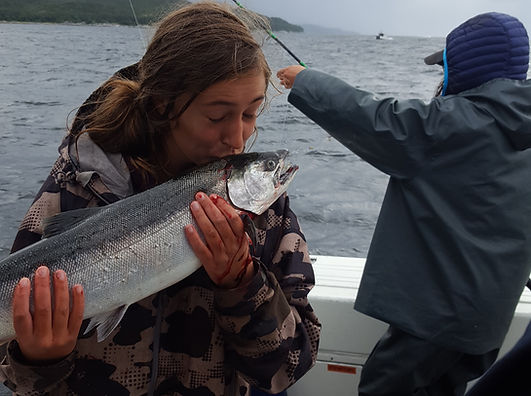
Alaskan Native
OWNED & OPERATED
Personalized Fishing Charters,
Sightseeing, & Whale Watching Tours


PROUD MEMBER OF THE:
Juneau Charter Boat Operators Association
BEST FISHING TIMES FOR JUNEAU

Salmon Fishing
Chinook (King) Salmon are fully mature salmon that are returning to the area to spawn. These fish average 20-25 lbs. and arrive in large numbers. Kings are the largest in the salmon family and can grow to over 70lbs. Typically in the Juneau Area we are targeting hatchery Kings. We do not engage in Salmon fishing prior to June 1st as over the past 8 years the Department of Fish and Game has closed retention of Kings between May 1st and May 31st. The early part of June is typically slower, however the catch rate impoves throughtout the month. The peak we have found is typically the last week of June and goes through the middle of July. Later in July the hatchery Kings start "turning" Once they have turned the quality of meat goes down. Once they turn to a certain point we will no longer keep the fish as the processor will not process it. Our crew will let you know as its determined on the individual fish.
Coho (Silver) Salmon arrive in the middle of June however the run picks up in numbers by the middle of July and remain until October. Silver salmon can reach weights of over 20 lbs. These salmon are surface fighters, making magnificent jumps when hooked.
Pink (Humpy) Salmon start showing up in late June. These are the smallest of our salmon, 3 to 6 lbs, but also the most numerous. Pinks are considered great fighters, for their size.
Chum (Dog) Salmon average 7 to 18 pounds, but can weigh as much as 32 pounds. They are the first salmon to spawn in the Juneau area. “Dog” Salmon by Alaskans—is unquestionably the most under-rated fish in Alaska. It is called a Dog Salmon because the native Alaskan people would feed this fish to their sled dogs in the winter. It is the least flavorful of the salmon. But having said that, they are a great fighting fish. The Chum Salmon, once hooked, will easily test the skill of the angler on the other end, as they make very strong runs.
Halibut Fishing


Halibut fishing in Juneau: Typically starts in June, however. We have had sucess in late may. We will not go out earlier than May 20th as the run is slow and we have to typically travel a fair distance to have a chance for sucess. I recommend calling to talk about the fishery before booking as it pertains to May Halibut fishing trips. We have found that the fishery picks up early June and by June 15th we feel the sucess rate or limiting out our guest in high.
The best fishing time for Halibut is middle of July and will taper off mid september. We have keep our boats avalible until september 24th in years past as we have had good success. Just know it is fishing and there is no guarentee.
For the 2026 Season - We have not been informed on any closure dates. We have a feeling that we will have a closure date and at this point I will be assuming it will be All Tuesdays starting May 13th through September 9th will be closed for Retention of Halibut. - Any angler 18 years and old who want to retain a Halibut will be required to purchase a RQE Halibut stamp which is $20.00 each. They can only be purchased at the time of booking. Once in the booking site follow all prompts. Call if you have any questions.
We are also Limited to1 Retention trip per day, per boat, per Halibut Permit" Retention trips will be 1 Halibut per angler with a slot limit of 37 inches and under or 80 inches and over.
While on a Charter boat the limit is 1 halibut per person and it does not matter if you are a resident or non-resident.
***We are offering Catch and Release trips. These trips are cheaper for you! all the while giving you an amazing experince an memorable trip. These trips will be avalible one our "Catch and Retained trips are booked". if its not avalible on the booking site feel free to call.
We do have options for you to purchase Halibut through one of our Processors / Vendor that can be shipped home. We understand it is not the fish you have caught on your trip, it is however Commercially caught, processed and very High quality. Overall it is a great way to bend some rods and make amazing memories while saving you a money. Also no limit of how many fish you can bring up and get amazing photos and videos. A few Halibut meals are great but the memories and photos last a lifetime.
Humpback Whales, Killer Whales and other Marine wildlife you could see on your adventures.














The Humpback Whale
Weight:
25-40 tons (50,000-80,000 pounds; 22,000-36,000 kg)
Newborns weigh about 1 ton (2,000 pounds; 900 kg) and are about 15 feet (4.5 m) long!
Length: up to 60 feet (18 m), with females larger than males.
Appearance: primarily dark grey, with some areas of white
Lifespan: about 50 years
Diet: tiny crustaceans (mostly krill), plankton, and small fish; they can consume up to 3,000 pounds (1360 kg) of food per day.
Behavior: breaching (jumping out of the water), or slapping the surface.
Killer Whales (Orca)
Diet: Carnivore (Marine Mammels) Seals, Sea-Lions and other sealife.
Average life span in the wild: 50 to 80 years
Size: 23 to 32 ft (7 to 9.7 m)
Weight: Up to 6 tons (5,443 kg
Killer whales are extremely distinctive with jet-black bodies and white patches usually over the eyes, under the jaw, on the belly, and extending onto their sides. Killer whales have 48 to 52 teeth that are large and conical shaped as well as slightly curved back and inward.
Steller Sea Lions
Weight: males: up to 2,500 pounds (1,120 kg) females: up to 770 pounds (350 kg) pups: about 35-50 pounds (16-22.5 kg)
Length: males: about 10-11 feet (3 - 3.4 m) females: about 7.5 - 9.5 feet (2.5 - 3.0 m) pups: about 3.3 feet (1 m)
Appearance: Adults are light blonde to reddish brown and slightly darker on the chest and abdomen.
Pups are dark brown to black.
Lifespan: 20-30 years
Diet: Variety of fish (capelin, cod, herring, mackerel, pollock, rockfish, salmon, sand lance, etc.), bivalves, squid, octopus, and gastropods.
Behavior: Use land habitat as haul-out sites for periods of rest, molting, and as rookeries for mating and pupping;
Colonial breeders, adult males ("bulls"), establish and defend territories on rookeries to mate.
Harbor Seals
Weight: about 245 pounds (110 kg)
Length: about 6 feet (~2 m)
Appearance: generally blue-gray back with light and dark speckling; they lack external ear flaps and have short forelimbs
Lifespan: about 25-30 years
Diet: mainly fish, shellfish, and crustaceans
Behavior: they tend to haul out on land and rest with head and flippers elevated, in a "banana-like" fashion.
Harbor seals are part of the "true seal" family, Phocidae. True seals lack external ear flaps and have short forelimbs that result in limited locomotion on land.
Dall's Porpoise
Weight:up to 480 pounds (220 kg)
Length:up to 7-8 feet (2-2.4 m)
Appearance: relatively small, triangular head with little or no beak and a thick, robust dark gray or black body, with variable contrasting white panels.
Lifespan: about 15-20 years
Diet:anchovies, herring, hake, smelts, squid, octopus, and occasionally crabs and shrimp
Behavior:usually found in groups averaging between 2-20 individuals; they also associate with Pacific white-sided dolphins and short-finned pilot whales.
*We choice and promote responsible whale watching and whale conservation practices. At all times we follow and adhere to the National Oceanic Atmospheric Administration (NOAA), Regulations for viewing Whales and Marine Mammals, no exceptions! ◦We will NOT place our vessel in the path of oncoming humpback whales.
◦We will NOT approach within 100 yards of any marine mammals.
◦We will NOT place our vessel in the path of oncoming humpback whales.
◦We will operate our vessel at a slow, safe speed and limit our noise.
◦We will limit our viewing time to 30 Minutes. Any longer is considered harassment the animal(s).

